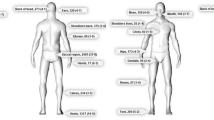Abstract
Objectives
To explore the causes and risk factors of inpatient death for patients with warfare-related limb trauma.
Methods
A retrospective study involving 339 patients with warfare-related limb trauma who were admitted to our hospital from 1998 to 2002 was conducted. Autopsy was performed for 15 cases who died in order to investigate the cause of death. Furthermore, based on the clinical features of warfare-related trauma patients, 11 factors were selected for further analysis: X1: causes of trauma, X2: shock after injury, X3: time from injury to hospital admission, X4: injured sites, X5: combined trauma (including head, thorax, abdomen, and vascular injury), X6: number of surgical procedures, X7: foreign body remaining, X8: fracture, X9: amputation, X10: duration of tourniquet homeostasis, X11: infection. All variables were available in all cases, and all parameters were quantified and fed into a computer. Multivariate statistical analysis was performed with a logistic regression model to elucidate the risk factors influencing death.
Results
Fifteen of the 339 inpatient cases died (4.4%). The causes were primarily acute renal failure (ARF) (seven cases, 46.7%), pulmonary embolism (PE) (three cases, 20.0%), multiple organ system failure (MOSF) (two cases, 13.3%), and gas gangrene (three cases, 20.0%). There was one case of gas gangrene with concomitant ARF, and one of gas gangrene with MOSF. The primary risk factors influencing death included shock, amputation, and complicating infection (P < 0.05).
Conclusion
The primary cause of death from warfare-related limb trauma is ARF. The appropriate and prompt management of shock patients, the correct timing of amputation, and the prevention and correct handling of infection are important in reducing mortality.
Similar content being viewed by others
References
Adegbehingbe OO, Akinyoola AL, Oginni LM. Predictive factors for primary amputation in trauma patients in a Nigerian university teaching hospital. East Afr Med J. 2006;83(10):539–44.
Allison CE, Trunkey DD. Battlefield trauma, traumatic shock and consequences: war-related advances in critical care. Crit Care Clin. 2009;25(1):31–45.
Bellomo R, Bonventre J, Macias W, Pinsky M. Management of early acute renal failure: focus on post-injury prevention. Curr Opin Crit Care. 2005;11(6):542–7.
Bryant AE, Bayer CR, Huntington JD, Stevens DL. Group A streptococcal myonecrosis: increased vimentin expression after skeletal-muscle injury mediates the binding of Streptococcus pyogenes. J Infect Dis. 2006;193(12):1685–92.
Brodie S, Hodgetts TJ, Ollerton J, McLeod J, Lambert P, Mahoney P. Tourniquet use in combat trauma: U.K. military experience. J Spec Oper Med. 2009;9(1):74–7.
Cairns BA, Stiffler A, Price F, Peck MD, Meyer AA. Managing a combined burn trauma disaster in the post-9/11 world: lessons learned from the 2003 West Pharmaceutical plant explosion. J Burn Care Rehabil. 2005;26(2):144–50.
Kragh JF, Walters TJ Jr, Baer DG, Fox CJ, Wade CE, Salinas J, Holcomb JB. Survival with emergency tourniquet use to stop bleeding in major limb trauma. Ann Surg. 2009;249(1):1–7.
Lenz M, Schmidt R, Muckley T, Donicke T, Friedel R, Hofmann GO. Wheelbarrow tire explosion causing trauma to the forearm and hand: a case report. J Med Case Rep. 2009;3:129.
Lu J, Wu XT, Kong XF, Tang WH, Cheng JM, Wang HL. Gas gangrene without wound: both lower extremities affected simultaneously. Am J Emerg Med. 2008;26(8):970e3–4.
Machiedo GW, Zaets SB, Berezina TL, Xu DZ, Feketova E, Spolarics Z, Deitch EA. Trauma-hemorrhagic shock-induced red blood cell damage leads to decreased microcirculatory blood flow. Crit Care Med. 2009;37(3):1000–10.
Oppert M, Engel C, Brunkhorst FM, Bogatsch H, Reinhart K, Frei U, Eckardt KU, Loeffler M, John S. Acute renal failure in patients with severe sepsis and septic shock–a significant independent risk factor for mortality: results from the German Prevalence Study. Nephrol Dial Transpl. 2008;23(3):904–9.
Stansbury LG, Branstetter JG, Lalliss SJ. Amputation in military trauma surgery. J Trauma. 2007;63(4):940–4.
Tsokos M, Schalinski S, Paulsen F, Sperhake JP, Püschel K, Sobottka I. Pathology of fatal traumatic and nontraumatic clostridial gas gangrene: a histopathological, immunohistochemical, and ultrastructural study of six autopsy cases. Int J Leg Med. 2008;122(1):35–41.
Vivino G, Antonelli M, Moro ML, Cottini F, Conti G, Bufi M, Cannata F, Gasparetto A. Risk factors for acute renal failure in trauma patients. Intensive Care Med. 1998;24(8):808–14.
Conflict of interest
None.
Author information
Authors and Affiliations
Corresponding author
Rights and permissions
About this article
Cite this article
Cheng, C.Z., Zhao, D.H., Li, Q.Y. et al. Causes of inpatient death for patients with warfare-related limb trauma and logistic regression analysis of the risk factors. Eur J Trauma Emerg Surg 38, 107–112 (2012). https://doi.org/10.1007/s00068-011-0146-x
Received:
Accepted:
Published:
Issue Date:
DOI: https://doi.org/10.1007/s00068-011-0146-x




